Using DECwindows Motif for OpenVMS
6.2.3 Selecting Scattered Files
To select files scattered throughout the file list:
- Point to the first file you want to select and click MB1.
- Press and hold the Shift key while you click MB1 on the other files
you want to select.
- Release the Shift key.
6.2.4 Selecting All Files in a Current Directory
To select all the files in the current directory, choose Select All
from the Selected menu on the File Selection menu bar. You can then
remove individual files from the selection by pointing to them,
pressing and holding the Shift key, and clicking MB1. You can remove
multiple files from the selection by pointing to them, pressing and
holding the Shift key and MB1, and dragging the pointer over them.
To cancel your file selection, choose Select None from the Selected
menu on the File Selection menu bar.
6.2.5 Selecting File Names in Other Windows
You can also select file names that appear in other windows by either
dragging the pointer through the file name or double clicking on it.
For more information about selecting text, see Chapter 3.
6.2.6 Displaying a Partial File List
Sometimes you want to screen some files out of the full file list and
display only a subset of files. Perhaps you want to display only those
files with a LOG file type or whose version number is 1. By using the
File Filter entry box, you can limit the list of files displayed.
To display a partial file list:
- Click on the File Filter entry box.
- Type the file or files you want listed.
For example, to list
all LOG files in your current directory, type *.LOG. When you use the
asterisk wildcard, FileView lists only the files that match the
characters you specified.
- Click on Apply.
You can specify a search list in the File Filter entry
box. A search list is a logical name that has more than one equivalence
name. It provides FileView with a list of places to look for a file. If
you use a search list in the File Filter, the file list automatically
displays the directory in which the file is located.
6.3 Working with Files
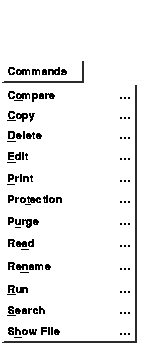
When you choose a command from FileView's Commands menu, you can
execute the command immediately or you can choose to display a command
dialog box. From a command's dialog box you can choose options to
tailor the file operation. For example, you can request that the Copy
command display a confirmation prompt each time you copy a file.
To execute a command without displaying a dialog box, select a file and
choose the command you want to use from FileView's Commands menu.
To display a dialog box when you use a command, choose the ellipsis
(...) next to the command you want to use from FileView's Commands
menu. If you do not select a file, FileView automatically displays a
dialog box.
Note
The procedures in the following sections describe how to use FileView's
commands by displaying command dialog boxes.
|
6.3.1 Applying Your Settings
Every FileView command dialog box contains push buttons you can use to
apply and save your settings, cancel the dialog box, or display help.
| Click on |
To |
|
OK
|
Start a task and dismiss the dialog box.
|
|
Apply
|
Start a task without dismissing the dialog box.
Note that when you use the Apply button, the OK, Apply, and Cancel
buttons are disabled until the task completes. When the task completes,
FileView reenables the OK, Apply, and Cancel buttons. You can then
perform another operation of the same type from the same box. For
example, you can choose Search to search repeatedly for different
strings on the selected file list without choosing Search again.
|
|
Save
|
Save your new settings until you change them.
|
|
Cancel
|
Dismiss the dialog box without changing any settings. If you made any
changes without applying them, clicking on the Cancel button cancels
those changes.
|
|
Help
|
Display help about the command.
|
6.3.2 Creating and Modifying Files
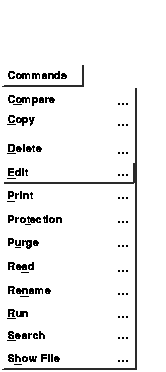
To edit a file:
- Select the file you want to edit.
- Choose the ellipsis (...) next to the Edit command on the Commands
menu.
FileView displays a dialog box.
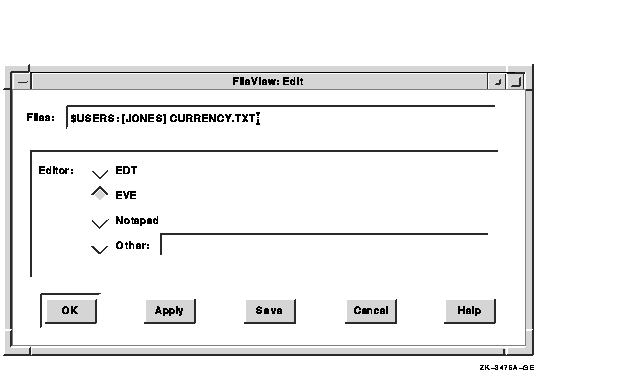
- Click on the editor you want to use.
To use an editor other
than those listed, type the appropriate DCL command for invoking the
editor in the entry box provided. FileView appends the file name of
each selected file to this Edit command.
- Click on OK.
If you clicked on EVE, FileView displays another dialog box in which
you can specify EVE settings. If you clicked on EDT, FileView opens a
Task Output window where you can edit your file using EDT. If you
clicked on Notepad, a Notepad window opens.
6.3.3 Reading Files
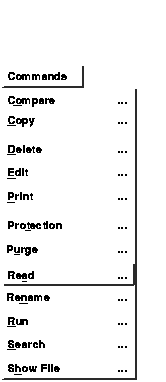
To view the contents of one or more files without making any changes,
use the Read command:
- Select the files you want to read.
- Choose the ellipsis (...) next to the Read command on the Commands
menu.
FileView displays a dialog box.
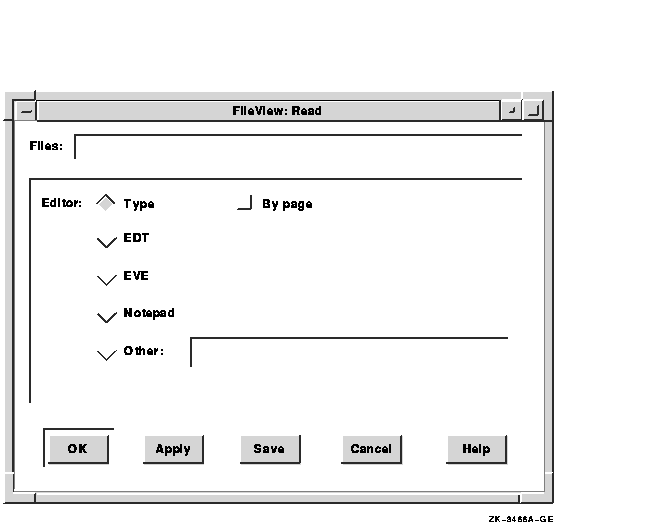
- To display a file, click on OK.
To alter the way a file is
displayed, choose any of the following options and click on OK:
| Enable this option |
To |
|
Reader
|
Specify the editor you want to use to read the file.
|
|
By Page
|
Display the file one page at a time.
|
- Click on OK to display the selected file.
6.3.4 Copying Files
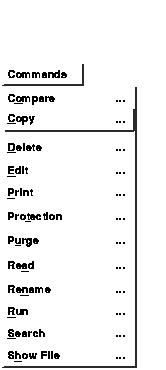
You can make a copy of a file to create a file with a new file name,
concatenate two or more files into a single file, or copy a group of
files to a group of new files. You can also enhance a copy operation by
choosing several options from the Copy dialog box.
When you copy a file, the original file remains unchanged.
6.3.4.1 Copying One File to Another File or Directory
To copy a file to a new name or to a different subdirectory:
- Select the file you want to copy.
- Choose the ellipsis (...) next to the Copy command on the Commands
menu.
FileView displays a dialog box.
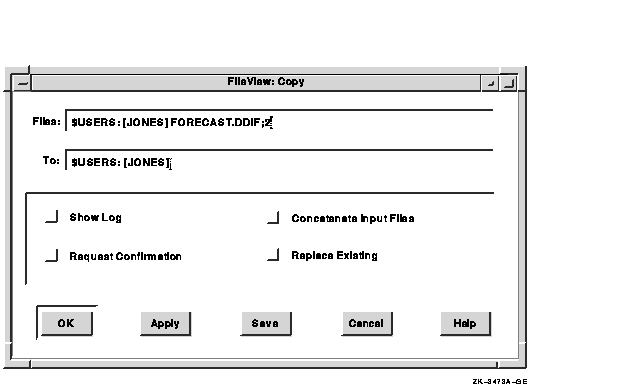
- Type the new file name or the name of the device and directory to
which you want to copy the file.
- To perform a simple copy operation, click on OK.
To alter the
way a copy operation is performed, choose any of the following options
and click on OK:
| Enable this option |
To |
|
Show Log
|
Display the name of each copied file. This check button is especially
helpful for checking whether multiple input files were copied to
multiple output files as you intended.
|
|
Request Confirmation
|
Display prompts asking whether to copy each selected file.
|
|
Concatenate Input Files
|
Create one output file from multiple input files if wildcard characters
are not used in the output file specification.
|
|
Replace
|
Replace the file that already exists with the output file specification
you entered. The copied file receives that file specification because
two files cannot have exactly the same file specification; that is, at
least the version number must be different.
|
6.3.4.2 Copying Groups of Files
You can concatenate two or more files into a single file, or copy
multiple input files to multiple output files. To copy a group of files
at the same time, you select the files and then copy them in one
operation. You can also tailor this copy operation by choosing options
from the Copy dialog box.
To copy a group of files in one operation:
- Select the files you want to copy.
- Choose the ellipsis (...) next to the Copy command on the Commands
menu.
FileView displays the Copy dialog box.
- Type the new file name or names, or the name of the device and
directory to which you want to copy the files.
- Click on OK.
If you specify multiple input files in the Copy dialog box, separate
them with commas. To create multiple output files, specify multiple
input files and include at least one of the following:
- An asterisk wildcard in the output directory, file name, file type,
or version number entry box
- Only a directory specification as the output file specification
When you create multiple output files, the corresponding field from
each input file specification is used in the output file specification.
If you do not specify a version number for the input and output files,
the Copy command assigns a version number to the output files that is
either of the following:
- The version number of the input file
- A version number one greater than the highest version number of an
existing file that has the same file name and file type
If you specify a version number in the output file specification, the
Copy command uses that number for the output file specification. If a
higher version of the output file already exists, a warning message
appears in the Task Output window, but the file is still copied. If an
equal version of the output file already exists, a message is issued
and the file is not copied. (Click on the Replace button in the Copy
dialog box to overwrite the existing file.)
The following example copies the files DIRECTIONS.TXT;1 and
PROVISIONS.LIS;1 to produce two output files, HOLIDAY.TXT;1 and
HOLIDAY.LIS;1:
From: $USERS:[JONES]DIRECTIONS.TXT;1,$USERS:[JONES]PROVISIONS.LIS;1
To: $USERS:[JONES]HOLIDAY.*;*
|
6.3.5 Searching Files for Text Strings
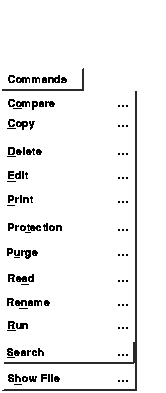
To search one or more files for one or more text strings:
- Select the files you want to search.
- Choose the ellipsis (...) next to the Search command on the
Commands menu.
FileView displays a dialog box.
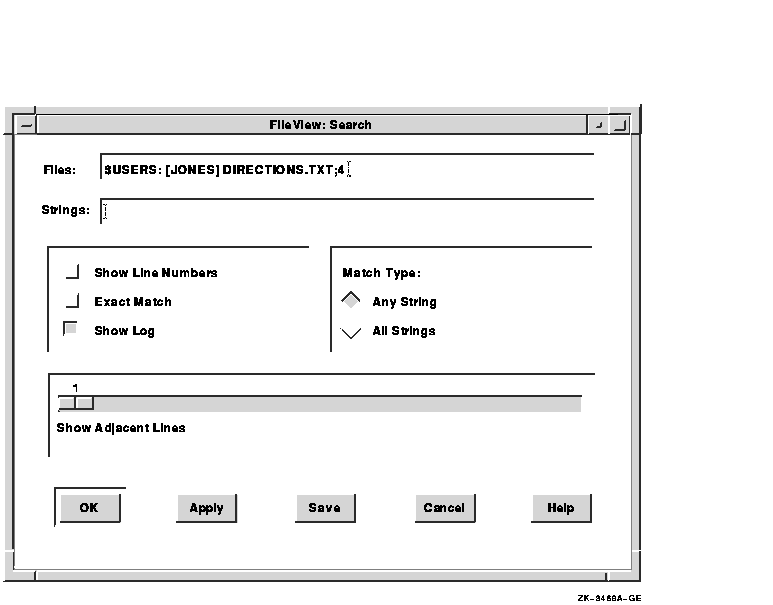
- Enter the text string for which you want to search.
- To perform a simple search operation, click on OK.
To alter the
way a search operation is performed, choose any of the following
options and click on OK:
| Enable this option |
To |
|
Exact Match
|
Find only those strings that exactly match the string you specified.
Use this option if you want the Search command to differentiate between
uppercase and lowercase letters.
|
|
Show Log
|
Display the file specification of each file as it is searched.
|
|
Match Type
|
Produce output only if the line contains all the strings when you
specify multiple search strings. Click on the Any String button to
produce output if the line contains any of the strings.
|
|
Show Line Numbers
|
Display the line number on which the text string is located in the file
being searched.
|
|
Show Adjacent Lines
|
Specify the number of lines to be displayed with the search string. By
default, only the line containing the search string is displayed.
|
To use wildcards in the file specifications of the files you want to
search, choose the Search command without first selecting any files. In
the following example, choosing the Search command and entering the
file specification as shown searches all versions of all files in the
current directory with the file type COM for the text string WRITE:
Files: *.COM
Strings: WRITE
|
6.3.6 Changing the Name of a File
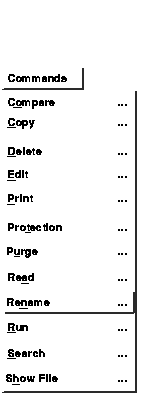
You can use the Rename command to
- Change all or part of a file specification of one or more existing
files
- Rename a group of files in one operation
- Change the name of the file or keep the same file name and move the
file to another directory
You cannot, however, use the Rename command to change the device on
which a file is located. When you rename a file, a copy of that file no
longer exists under its original name.
6.3.6.1 Renaming a File
To change all or part of a file specification of an existing file:
- Select the file you want to rename.
- Choose the ellipsis (...) next to the Rename command on the
Commands menu.
FileView displays a dialog box.
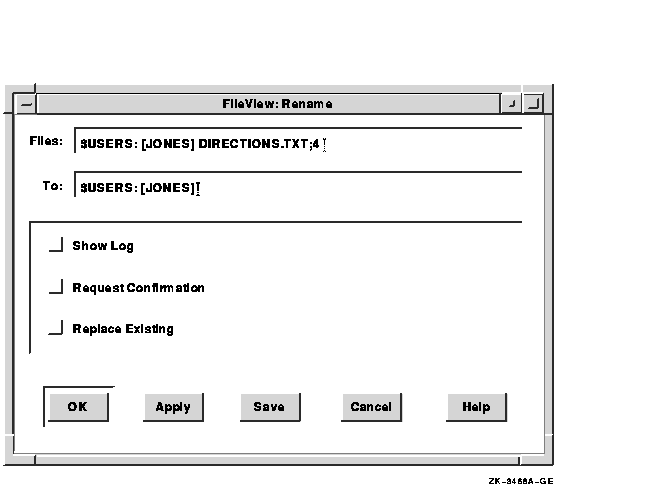
- Type the new file name.
- To perform a simple rename operation, click on OK.
To alter the
way a rename operation is performed, choose any of the following
options and click on OK:
| Enable this option |
To |
|
Show Log
|
Display the file specification of each file as it is renamed. This
check button is especially helpful for verifying whether multiple input
files were renamed to multiple output files as you intended.
|
|
Request Confirmation
|
Display a prompt asking whether to rename the file.
|
|
Replace Existing Files
|
Replace the file that already exists with the output file specification
you entered. The renamed file is given that file specification because
two files cannot have exactly the same file specification.
|
If you choose the Rename command without first selecting a file, type
the name of the file you want to rename in the Rename dialog box.
If FileView cannot rename the file, it displays the word Error in the
Work in Progress dialog box. To open the Task Output window to see the
error message, click on the Show Output button. Click on the OK button
in the Task Output window when you finish viewing the message.
In the following example, choosing the Rename command and entering the
file specifications in the Rename dialog box as shown changes the
directory specification of DIRECTIONS.TXT from your top-level directory
to the SCHEDULES subdirectory. (DIRECTIONS.TXT is moved to the
SCHEDULES subdirectory.)
From: DIRECTIONS.TXT
To: [.SCHEDULES]
|
6.3.6.2 Renaming Groups of Files
You can rename multiple files in one operation. The simplest way to
rename multiple files is to select them in your file list and rename
them as you would one file.
You can also rename multiple input files to multiple output files by
specifying wildcard characters in corresponding entry boxes of the
input and output file specifications. Just as when you renamed one
file, you can tailor this operation by choosing options from the Rename
dialog box.
If entry boxes in the output file specification are omitted or are
replaced by wildcard characters, the Rename command uses the device,
directory, file name, and file type of the input file specification to
name the corresponding fields in the output file specification.
The version number is determined in the following ways:
- If you specify an explicit version number in the output file
specification, that version number is used.
- If you specify a wildcard as the version number in the output file
specification, the version number of the input file is used.
- If you specify a wildcard as the version number in the input file
specification, the version number of each input file is used to name a
corresponding output file.
- If no file exists with the same file name and type as the output
file, a version number of 1 is used.
- If a file already exists with the same file name and type as the
output file, the next higher version number is used.
To rename multiple files in one operation using wildcards:
- Choose the ellipsis (...) next to the Rename command on the
Commands menu.
FileView displays a dialog box.
- Type the file specifications of the files you want to rename.
Separate them with commas.
- Type the file specification to which you want the files renamed.
- Click on OK.
In the following example, choosing the Rename command and entering the
file specification in the Rename dialog box as shown renames all
versions of all files in $USERS:[JONES] with the file type TXT to the
file type OLD. The file names and version numbers are not changed.
From: *.TXT;*
To: $USERS:[JONES]*.OLD;*
|
6.3.7 Comparing the Contents of Files
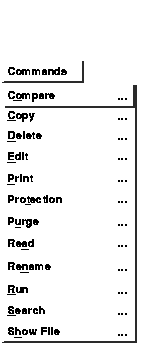
To compare the contents of two files and view a listing of the lines
that do not match:
- Select the first file you want to compare.
- Choose the ellipsis (...) next to the Compare command on the
Commands menu.
FileView displays a dialog box.
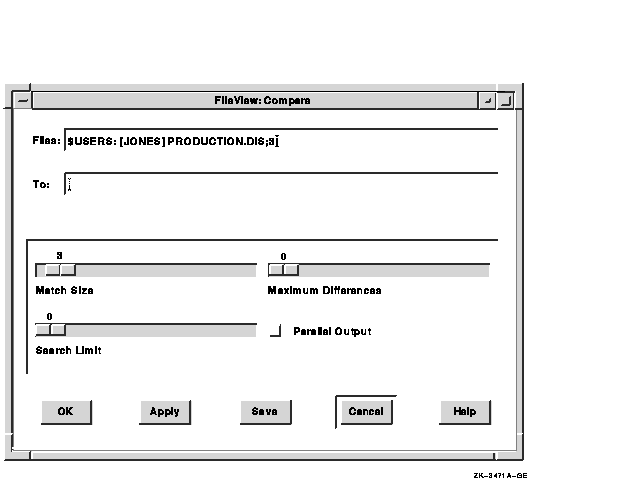
The To entry box contains the text ;-1. This means that the
selected file will be compared with its previous version. To compare
the selected file with a file other than its previous version, double
click on the text in the To entry box and type another file
specification.
- To perform a simple compare operation, click on OK.
To alter
the way each compare operation matches lines, choose any of the
following options and click on OK:
| Enable this option |
To |
|
Parallel Output
|
List the lines with differences side by side.
|
|
Match Size
|
Specify the number of lines that should again indicate matching data
after differences are found. Once the Compare command finds unmatched
lines, it considers the files matching once again after it finds three
sequential lines that match. Use the Match slider to override the match
size of 3.
|
|
Maximum Differences
|
Terminate the compare operation after the specified number of unmatched
lines is found. This number can be from 0 to 100, where 0 indicates no
maximum.
|
|
Search Limit
|
Specify how many lines should be searched before a line is considered
unmatched. Unless you specify otherwise, the Compare command searches
to the ends of both files being compared before it lists a line as
unmatched. This number can be from 0 to 100, where 0 indicates no
maximum.
|
If you choose the Compare command without first selecting a file, type
the name of the file you want to compare with its previous version.
The following example shows the results of an operation in which the
files PROJECTIONS.LIS;2 and PROJECTIONS.LIS;1 are compared:
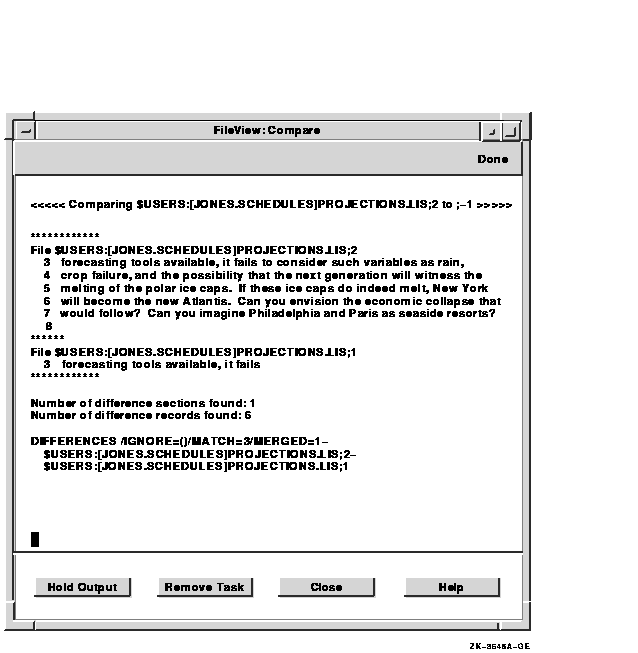
In the following example, choosing the Compare command and entering the
file specification in the Compare dialog box as shown compares the
contents of the TRADE_BARRIERS.TXT with EMBARGOES.TXT:
Files: TRADE_BARRIERS.TXT
To: EMBARGOES.TXT
|
6.3.8 Displaying Information About Files
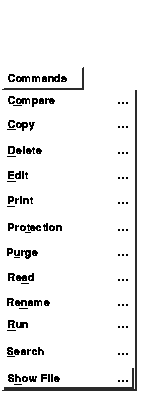
You can obtain information about a file or group of files by using the
Show File command. This information can include the file's size,
creation date, protection settings, and last backup date.
To obtain information about a file:
- Select the about which file you want information.
- Choose the ellipsis (...) next to the Show File command on the
Commands menu.
FileView displays a dialog box.
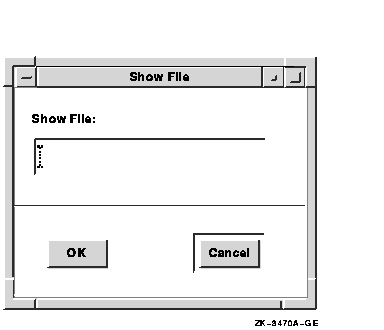
To use wildcards in the file specifications of the files you want
information about, choose the Show File command without first selecting
any files. In the following example, choosing the Show File command and
entering the file specification as shown displays information about all
files in the $USERS:[JONES] with the file type PS:
Show File: $USERS:[JONES]*.PS
|
Output from the Show File command looks similar to this:
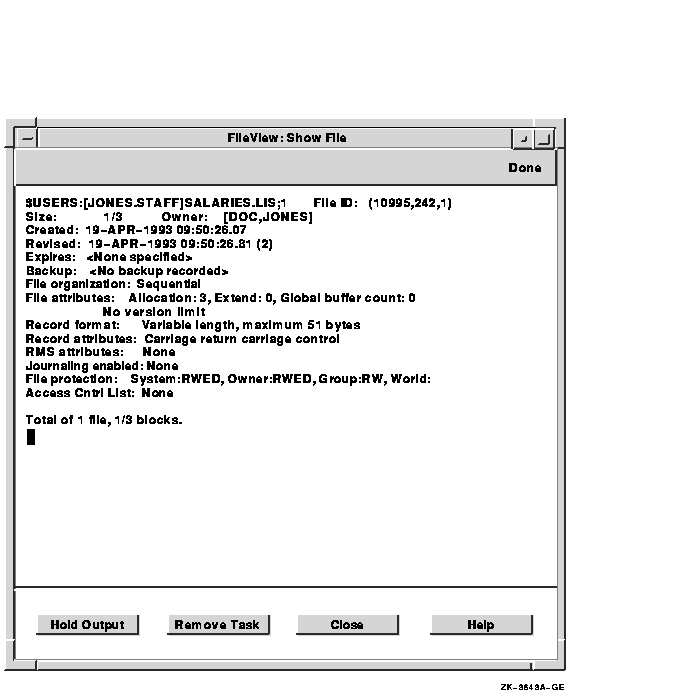
6.3.9 Purging Files
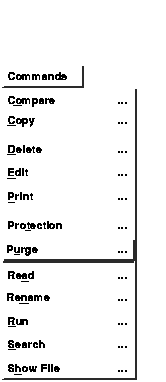
Every time you modify a file, another version of the file is added to
your directory. If you find yourself with multiple versions of a file,
use the Purge command to delete all older versions. Purging your
directory makes room on your disk for other files.
By default, the file list displays only the highest version of each
file. If you have not changed this setting, you can purge your entire
directory in one operation by selecting all the files. If your file
list displays all versions of your files, you must select only the
highest versions of each file for purging.
To purge one or more files:
- Select the files you want to purge.
- Choose the ellipsis (...) next to the Purge command on the Commands
menu.
FileView displays a dialog box.
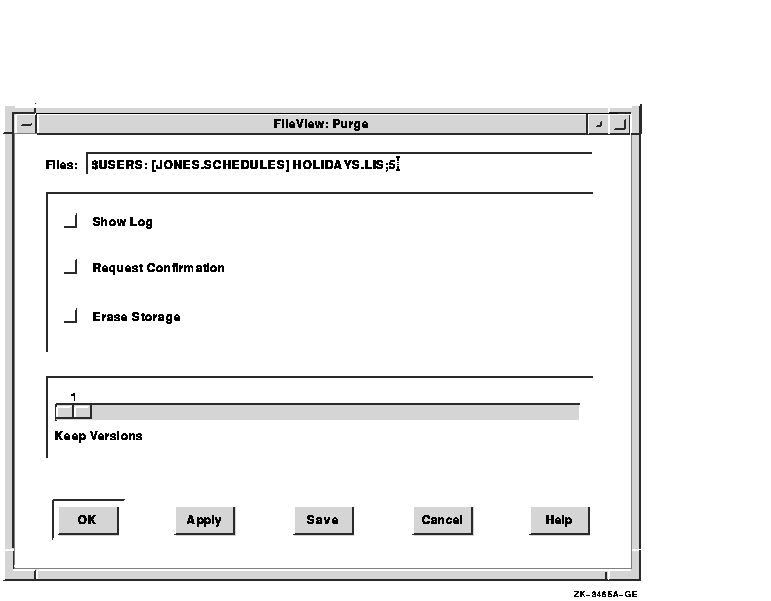
- To perform a simple purge operation, click on OK.
To alter the
way a purge operation is performed, choose any of the following options
and click on OK:
| Enable this option |
To |
|
Show Log
|
Display the file specifications of each file as it is deleted.
|
|
Request Confirmation
|
Display a prompt asking whether to purge the file.
|
|
Erase Storage
|
Erase the selected files from your disk so that the purged data no
longer physically exists.
|
|
Keep Versions
|
Retain the specified number of versions (starting with the highest) of
each file. Unless you specify otherwise, all but the latest versions of
the specified files are deleted. Use the Keep Versions slider to keep
more than the highest version of each file.
|
If you choose the Purge command without first selecting the file, you
are prompted to type the name of the file you want to purge.
To use wildcards in the file specifications of the files you want
purged, choose the Purge command without first selecting any files. In
the following example, choosing the Purge command and entering the file
specification as shown purges all files with the letter L in their file
name and a file type of COM:
|







